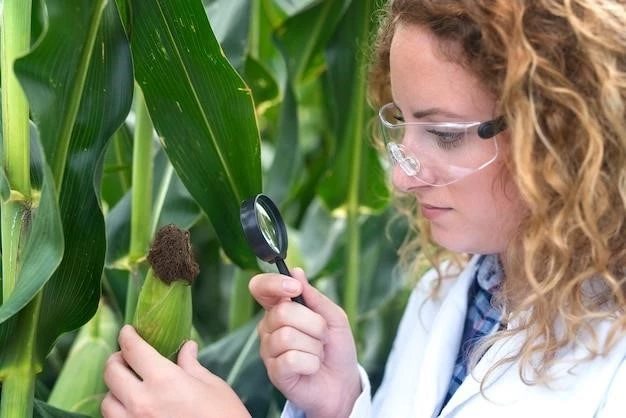Disease ⏤ Farmers Lung
Farmers Lung, also known as Hypersensitivity Pneumonitis, is a disease that affects agricultural workers due to the exposure to organic dust such as mold spores, hay, grain, straw, silage, and compost. This article will outline the causes, symptoms, diagnosis, treatment, and prevention strategies for Farmers Lung.
Introduction
Farmers Lung, also known as Hypersensitivity Pneumonitis, is a type of allergic reaction that affects the lungs and is triggered by the inhalation of agricultural dust containing organic substances. This condition primarily impacts individuals who work in agriculture or have regular exposure to organic materials found on farms.
Exposure to mold spores, hay, grain, straw, silage, and compost can lead to the development of Farmers Lung. This disease is characterized by an inflammatory response in the respiratory tract, leading to symptoms such as coughing, wheezing, shortness of breath, chest tightness, fatigue, fever, chills, joint pain, headache, nail clubbing, and weight loss.
Understanding the causes, symptoms, diagnosis, treatment, and prevention of Farmers Lung is crucial for agricultural workers to protect themselves from this potentially debilitating condition. Proper knowledge and awareness can help reduce the risk of developing Farmers Lung and improve the overall health and well-being of individuals working in the agricultural sector.
Causes and Risk Factors
Farmers Lung, or Hypersensitivity Pneumonitis, is primarily caused by the inhalation of agricultural dust containing organic substances. Agricultural workers who handle materials such as mold spores, hay, grain, straw, silage, and compost are at higher risk of developing this condition due to their frequent exposure to these organic allergens.
When these organic dust particles are inhaled, the immune system of susceptible individuals may overreact, leading to inflammation in the lungs. Prolonged and repeated exposure to these triggers can result in the development of Farmers Lung.
Key risk factors for Farmers Lung include⁚
- Occupation⁚ Individuals working in agriculture, including farmers, farm workers, and livestock handlers, are at a higher risk due to their close contact with organic materials.
- Exposure⁚ Regular exposure to mold spores, hay, grain, straw, silage, and compost increases the likelihood of developing Farmers Lung.
- Susceptibility⁚ Some individuals may be genetically predisposed to allergic reactions, making them more vulnerable to Farmers Lung.
- Poor Ventilation⁚ Working in poorly ventilated environments where dust particles are concentrated can exacerbate the risk of developing this condition.
By understanding the causes and risk factors associated with Farmers Lung, agricultural workers can take proactive measures to minimize their exposure to organic dust and protect their respiratory health. Implementing preventive strategies is essential in reducing the incidence of this occupational lung disease among individuals working in the agricultural sector.
Symptoms
Farmers Lung, or Hypersensitivity Pneumonitis, manifests with a range of symptoms that affect the respiratory system and overall well-being of individuals exposed to organic dust in agricultural settings. Recognizing these symptoms is crucial for early detection and management of the condition.
Common symptoms of Farmers Lung include⁚

- Coughing⁚ Persistent coughing, especially after exposure to organic dust, is a hallmark symptom of Farmers Lung.
- Wheezing⁚ Wheezing or a whistling sound when breathing may occur due to airway inflammation and constriction.
- Shortness of Breath⁚ Difficulty breathing, particularly during physical exertion, can be a significant symptom of Farmers Lung.
- Chest Tightness⁚ A feeling of pressure or tightness in the chest may be experienced as a result of lung inflammation.
- Fatigue⁚ Persistent tiredness and lack of energy can accompany the respiratory symptoms of Farmers Lung.
- Fever⁚ Some individuals may experience fever as a sign of the body’s immune response to the allergens.
- Chills⁚ Cold shivers or chills may accompany fever and other systemic symptoms.
- Joint Pain⁚ Pain and discomfort in the joints may occur as an inflammatory response to the allergens.
- Headache⁚ Persistent headaches can be a symptom of Farmers Lung, especially when exposed to triggers.
- Nail Clubbing⁚ Changes in the nails, such as enlargement and curvature of the fingertips, may be observed in advanced cases of Farmers Lung.
- Weight Loss⁚ Unintentional weight loss can occur due to the systemic effects of the disease on the body.
Recognizing these symptoms and seeking prompt medical attention is essential for the proper diagnosis and management of Farmers Lung. Early intervention can help alleviate symptoms and prevent the progression of this occupational lung disease in agricultural workers.
Diagnosis
Diagnosing Farmers Lung involves a combination of medical history assessment, physical examination, and specialized testing to confirm the presence of the condition. Healthcare providers rely on various diagnostic tools to accurately identify Farmers Lung and differentiate it from other respiratory disorders.
The diagnostic process for Farmers Lung may include the following⁚
- Medical History⁚ Healthcare providers will inquire about the individual’s occupation, exposure to organic dust, and the onset of respiratory symptoms to understand the potential link to Farmers Lung.
- Physical Examination⁚ A thorough physical exam, including listening to the lungs with a stethoscope, may reveal abnormal sounds associated with lung inflammation and respiratory distress.
- Pulmonary Function Tests (PFTs)⁚ These tests assess lung function, including the ability to breathe in and out effectively. PFTs can help identify airflow limitations and assess the severity of respiratory impairment.
- Chest X-ray⁚ An X-ray of the chest can provide detailed images of the lungs to detect signs of inflammation, scarring, or other abnormalities associated with Farmers Lung.
- High-Resolution CT Scan⁚ A CT scan may be recommended to obtain more detailed images of the lungs, enabling healthcare providers to evaluate the extent of lung damage and inflammation.
- Blood Tests⁚ Blood tests can help assess the levels of inflammation markers, antibodies, and other substances that indicate an immune response to organic allergens.
- Lung Biopsy⁚ In some cases, a lung biopsy may be performed to collect a sample of lung tissue for further analysis under a microscope. This invasive procedure can help confirm the presence of Farmers Lung and rule out other lung conditions.
Diagnostic tests play a crucial role in confirming Farmers Lung and guiding treatment decisions. Healthcare providers utilize a comprehensive approach to diagnose this occupational lung disease accurately and develop an individualized management plan for affected individuals in agricultural settings.
Treatment
The treatment of Farmers Lung focuses on alleviating symptoms, managing inflammation, and preventing further lung damage in individuals affected by this condition. Healthcare providers may recommend a combination of pharmacological and non-pharmacological interventions to address the respiratory symptoms and improve the quality of life of agricultural workers impacted by Farmers Lung.
Treatment approaches for Farmers Lung may include the following⁚
- Avoidance of Allergens⁚ The primary step in managing Farmers Lung involves minimizing exposure to organic dust and allergens found in agricultural settings. Implementing proper ventilation, using respiratory protective equipment, and taking breaks from high-exposure tasks can help prevent symptom exacerbation.
- Medications⁚ Healthcare providers may prescribe medications to reduce inflammation, alleviate respiratory symptoms, and control immune responses. Corticosteroids and immunosuppressants are commonly used to manage lung inflammation in Farmers Lung.
- Bronchodilators⁚ Bronchodilator medications may be prescribed to help relax the airway muscles and improve breathing in individuals experiencing wheezing and shortness of breath.
- Oxygen Therapy⁚ In cases of severe respiratory impairment, supplemental oxygen therapy may be necessary to ensure an adequate oxygen supply to the body and improve overall lung function.
- Pulmonary Rehabilitation⁚ Pulmonary rehabilitation programs can help individuals with Farmers Lung improve lung capacity, exercise tolerance, and overall respiratory function through structured exercise routines and education on managing symptoms.
- Dietary Modifications⁚ A balanced diet rich in nutrients can support overall health and immune function in individuals with Farmers Lung. Adequate hydration and nutritional support are essential for optimal lung health.
- Monitoring and Follow-Up⁚ Regular follow-up appointments with healthcare providers are critical to monitor the progression of Farmers Lung, adjust treatment plans as needed, and address any emerging symptoms or complications.
Individuals diagnosed with Farmers Lung should work closely with healthcare providers to develop a comprehensive treatment plan tailored to their specific needs and health status. By following the prescribed treatment regimen and making lifestyle adjustments to minimize exposure to allergens, agricultural workers can effectively manage Farmers Lung and improve their long-term respiratory health.
Prevention
Preventing Farmers Lung involves implementing various strategies to reduce exposure to organic dust and allergens in agricultural environments. Agricultural workers can take proactive measures to protect their respiratory health and minimize the risk of developing this occupational lung disease.
Key preventive measures for Farmers Lung include⁚
- Use of Protective Equipment⁚ Wearing appropriate respiratory protective equipment, such as masks or respirators, can help filter out organic dust particles and reduce inhalation exposure in susceptible individuals.
- Proper Ventilation⁚ Ensuring adequate ventilation in barns, silos, and other agricultural spaces can help disperse dust particles and maintain air quality, reducing the concentration of allergens in the environment.
- Regular Cleaning⁚ Regularly cleaning and maintaining agricultural facilities, equipment, and storage areas can help prevent the accumulation of dust, mold spores, and other organic materials that can trigger Farmers Lung.
- Moistening Hay and Straw⁚ Dampening hay, straw, and other organic materials before handling or storage can help minimize the release of dust particles and reduce respiratory exposure to allergens.
- Limiting Dust Exposure⁚ Minimizing direct contact with dusty materials and reducing activities that generate airborne particles can lower the risk of inhaling organic dust and developing respiratory symptoms.
- Education and Training⁚ Providing education and training to agricultural workers on the risks of Farmers Lung, proper handling of organic materials, and the use of protective measures can raise awareness and promote safe practices in farm environments.
- Medical Surveillance⁚ Establishing regular medical screenings and surveillance programs for agricultural workers can help identify early signs of respiratory issues, monitor lung function, and prompt timely intervention if Farmers Lung is suspected.
- Workplace Policies⁚ Implementing workplace policies that prioritize respiratory health, safety protocols, and dust control measures can create a safer working environment for agricultural workers and reduce the risk of occupational lung diseases.
By adopting preventive strategies and promoting a culture of respiratory health and safety in agricultural settings, individuals can mitigate the risk of Farmers Lung and protect their lungs from the harmful effects of organic allergens. Proactive prevention measures play a crucial role in safeguarding the well-being of agricultural workers and promoting long-term respiratory wellness.
Conclusion
In conclusion, Farmers Lung, also known as Hypersensitivity Pneumonitis, poses a significant health risk to agricultural workers exposed to organic dust and allergens in farm environments. This occupational lung disease can lead to respiratory symptoms, inflammation, and long-term lung damage if not properly managed.
Recognizing the causes, symptoms, and risk factors of Farmers Lung is essential for early detection and intervention. By understanding the importance of preventive measures such as using protective equipment, ensuring proper ventilation, and minimizing dust exposure, agricultural workers can reduce their susceptibility to this debilitating condition.
Diagnosis and treatment of Farmers Lung require a multidisciplinary approach, involving healthcare providers, occupational health professionals, and agricultural workers themselves. Through prompt diagnosis, adherence to treatment plans, and regular monitoring of lung function, individuals impacted by Farmers Lung can better manage their symptoms and prevent disease progression.
Preventive strategies play a critical role in safeguarding the respiratory health of agricultural workers and creating safer work environments. Education, training, and workplace policies focused on respiratory safety can help minimize the risk of Farmers Lung and improve overall worker well-being.
As ongoing research continues to enhance our understanding of Farmers Lung and its impact on agricultural workers, advocacy for respiratory health awareness and occupational safety measures remains paramount. By prioritizing lung health, implementing preventive interventions, and supporting affected individuals, we can strive towards reducing the burden of Farmers Lung and promoting a healthier future for those working in agriculture.
